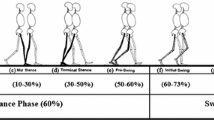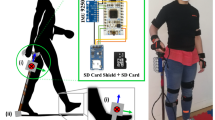Abstract
Human gait can be quantified using motion capture systems. Three-dimensional (3D) gait analysis is considered the gold standard for gait assessment. However, the process of three-dimensional analysis is cumbersome and time-consuming. It also requires complex software and a sophisticated environment. Hence, it is limited to a smaller section of the population. We, therefore, aim to develop a system that can predict abnormal walking patterns by analyzing trunk lean and knee angle information. A vision-based OpenPose algorithm was used to calculate individual trunk lean and knee angles. Web applications have been integrated with this algorithm so that any device can use it. A Miqus camera system of Qualisys 3D gait analysis system was used to validate the OpenPose algorithm. The validation method yielded an error of ± 9° in knee angle and ± 8° in trunk lean. The natural walking pattern of 100 healthy individuals was compared to simulated walking patterns in an unconstrained setting in order to develop a machine learning program. From the collected data, an RNN-based LSTM machine learning model was trained to distinguish between normal and abnormal walkings. LSTM-based models were able to distinguish between normal and abnormal gaits with an accuracy of 80%. This study shows that knee angle and trunk lean patterns collected during walking can be significant indicators of abnormal gait.
Access this chapter
Tax calculation will be finalised at checkout
Purchases are for personal use only
Similar content being viewed by others
References
Davis III RB, Ounpuu S, Tyburski D, Gage JR (1991) A gait analysis data collection and reduction technique. Human Movement Sci 10(5):575–87. https://doi.org/10.1016/0167-9457(91)90046-Z
Clayton HM (1996) Instrumentation and techniques in locomotion and lameness. Veterinary Clinics North Am: Equine Practice 12(2):337–350. https://doi.org/10.1016/S0749-0739(17)30285-7
Reinschmidt C, Van Den Bogert AJ, Nigg BM, Lundberg A, Murphy N (1997) Effect of skin movement on the analysis of skeletal knee joint motion during running. J Biomech 30(7):729–732. https://doi.org/10.1016/S0021-9290(97)00001-8
Tao W, Liu T, Zheng R, Feng H (2012) Gait analysis using wearable sensors. Sensors 12(2):2255–2283. https://doi.org/10.3390/s120202255
Muro-De-La-Herran A, Garcia-Zapirain B, Mendez-Zorrilla A (2014) Gait analysis methods: an overview of wearable and non-wearable systems, highlighting clinical applications. Sensors 14(2):3362–3394. https://doi.org/10.3390/s140203362
Gabel M, Gilad-Bachrach R, Renshaw E, Schuster A (2012) Full body gait analysis with Kinect. In: Annual international conference of the IEEE engineering in medicine and biology society 2012. IEEE, San Diego, California, USA, pp 1964–1967. https://doi.org/10.1109/EMBC.2012.6346340
Han J, Shao L, Xu D, Shotton J (2013) Enhanced computer vision with microsoft kinect sensor: a review. IEEE Trans Cybern 43(5):1318–1334. https://doi.org/10.1109/TCYB.2013.2265378
Livingston MA, Sebastian J, Ai Z, Decker JW (2012) Performance measurements for the Microsoft Kinect skeleton. IEEE Virtual Reality Workshops (VRW) 2012. IEEE, Costa Mesa, CA, USA, pp. 119–120. https://doi.org/10.1109/VR.2012.6180911
Viswakumar A, Rajagopalan V, Ray T, Parimi C (2019) Human gait analysis using OpenPose. In: Fifth international conference on image information processing (ICIIP) 2019. IEEE.Waknaghat, Shimla, Himanchal, pp 310–314. https://doi.org/10.1109/ICIIP47207.2019.8985781
Lin TY, Maire M, Belongie S, Hays J, Perona P, Ramanan D, Dollár P, Zitnick CL.: Microsoft COCO: Common objects in context. European conference on computer vision 2014. Springer. Zurich, Switzerland, pp 740–755. https://doi.org/10.1007/978-3-319-10602-1_48
Stenum J, Rossi C, Roemmich RT (2021) Two-dimensional video-based analysis of human gait using pose estimation. PLoS Comput Biol 17(4):e1008935. https://doi.org/10.1371/journal.pcbi.1008935
Toshev A, Szegedy C.: Deeppose (2014) Human pose estimation via deep neural networks. IEEE conference on computer vision and pattern recognition 2014. IEEE, Colubus, OH, USA, pp 1653–1660. https://doi.org/10.1109/CVPR.2014.214
Dolatabadi E, Taati B, Mihailidis A (2017) An automated classification of pathological gait using unobtrusive sensing technology. IEEE Trans Neural Syst Rehabil Eng 25(12):2336–2346. https://doi.org/10.1109/TNSRE.2017.2736939
Lai DTH, Begg RK, Palaniswami M (2009) Computational intelligence in gait research: a perspective on current applications and future challenges. IEEE Trans Inf Technol Biomed 13(5):687–702. https://doi.org/10.1109/TITB.2009.2022913
**novart T, Cai X, Thonglek K (2020) Abnormal gait recognition in real-time using recurrent neural networks. In: 59th IEEE conference on decision and control (CDC) 2020. IEEE, Jeju, Korea (South), pp 972–977. https://doi.org/10.1109/CDC42340.2020.93041
Hunt MA, Birmingham TB, Bryant D, Jones I, Giffin JR, Jenkyn TR, Vandervoort AA (2008) Lateral trunk lean explains variation in dynamic knee joint load in patients with medial compartment knee osteoarthritis. Osteoarthritis Cartilage 16(5):591–599. https://doi.org/10.1016/j.joca.2007.10.017
Simic M, Hunt MA, Bennell KL, Hinman RS, Wrigley TV (2012) Trunk lean gait modification and knee joint load in people with medial knee osteoarthritis: the effect of varying trunk lean angles. Arthritis Care Res 64(10):1545–1553. https://doi.org/10.1002/acr.21724
Kinsella S, Moran K (2008) Gait pattern categorization of stroke participants with equinus deformity of the foot. Gait Posture 27(1):144–151. https://doi.org/10.1016/j.gaitpost.2007.03.008
Cao Z, Simon T, Wei SE, Sheikh Y (1017) Realtime multi-person 2d pose estimation using part affinity fields. In: IEEE conference on computer vision and pattern recognition 2017, pp 7291–7299. https://doi.org/10.48550/ar**v.1611.08050
Kumar N, Pankaj D, Mahajan A, Kumar A, Sohi BS (2009) Evaluation of normal gait using electro-goniometer. J Sci Indus Res 68(8):696–8. http://nopr.niscpr.res.in/handle/123456789/5302
Favre J, Erhart-Hledik JC, Chehab EF, Andriacchi TP (2016) General scheme to reduce the knee adduction moment by modifying a combination of gait variables. J Orthop Res 34(9):1547–1556. https://doi.org/10.1002/jor.23151
Favre J, Jolles BM (2016) Gait analysis of patients with knee osteoarthritis highlights a pathological mechanical pathway and provides a basis for therapeutic interventions. EFORT open reviews 1(10):368–374. https://doi.org/10.1302/2058-5241.1.000051
https://www.qualisys.com/ Last accesses 29 May 2022
Hochreiter S, Schmidhuber J (1997) Long short-term memory. Neural Comput 9(8):1735–1780. https://doi.org/10.1162/neco.1997.9.8.1735
Nair V, Hinton GE (2010) Rectified linear units improve restricted boltzmann machines. In: International conference on machine learning 2010. Haifa, Israel (2010). https://doi.org/10.5555/3104322.3104425
Kingma DP, Ba JA )(2015) A method for stochastic optimization. In: 3rd International conference for learning representation 2015 9, ar**vpp1412.6980. San Diego (2015). https://doi.org/10.48550/ar**v.1412.6980
Rumelhart DE, Hinton GE, Williams RJ (1986) Learning representations by back-propagating errors. Nature 323(6088):533–536. https://doi.org/10.1038/323533a0
Author information
Authors and Affiliations
Corresponding author
Editor information
Editors and Affiliations
Rights and permissions
Copyright information
© 2023 The Author(s), under exclusive license to Springer Nature Singapore Pte Ltd.
About this paper
Cite this paper
Pandit, P., Thummar, D., Verma, K., Gangadharan, K.V., Das, B., Kamat, Y. (2023). Importance of Knee Angle and Trunk Lean in the Detection of an Abnormal Walking Pattern Using Machine Learning. In: Sharma, S., Subudhi, B., Sahu, U.K. (eds) Intelligent Control, Robotics, and Industrial Automation. RCAAI 2022. Lecture Notes in Electrical Engineering, vol 1066. Springer, Singapore. https://doi.org/10.1007/978-981-99-4634-1_42
Download citation
DOI: https://doi.org/10.1007/978-981-99-4634-1_42
Published:
Publisher Name: Springer, Singapore
Print ISBN: 978-981-99-4633-4
Online ISBN: 978-981-99-4634-1
eBook Packages: Intelligent Technologies and RoboticsIntelligent Technologies and Robotics (R0)




